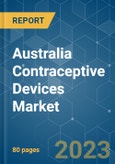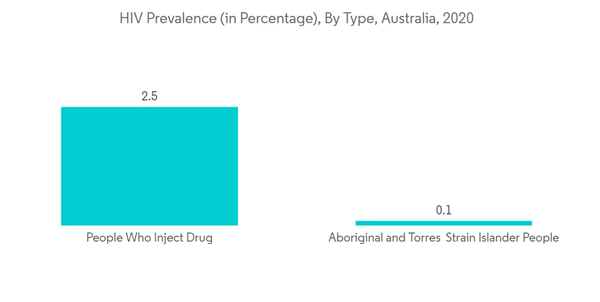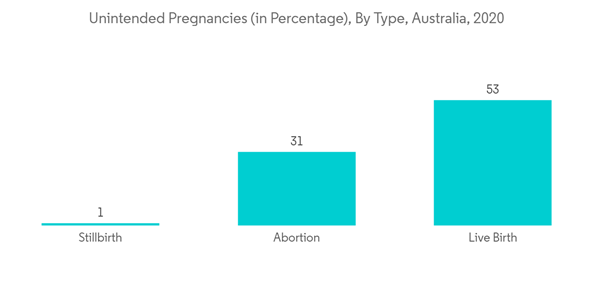Millions of women and girls worldwide had lost access to contraceptive and abortion services due to the COVID-19 epidemic. Lockdowns, travel restrictions, supply chain disruptions, and a significant shift in health resources to battle COVID-19 have contributed to the rise in the number of unintended pregnancies in the country. Also, according to the study published in the European Journal of Contraceptives and Reproduction in August 2022, women who were working had easier access to contraceptives during the shutdown. COVID-19 caused people to postpone childbearing or decide against having children. Thus, during the pandemic, a greater percentage of women were against childbearing, which created a demand for contraception. As a result, the investigated market was positively impacted during the epidemic. However, the studied market will follow the same trend during the forecast period due to the growing burden of sexually transmitted diseases and the rising demand for contraceptives in Australia. For instance, according to the press release by Durex in September 2021, the company saw a 10% increase in condom sales once restrictions were relaxed in Sydney, Australia.
Rising cases of sexually transmitted diseases and the initiatives taken by the government of Australia and other organizations concerning the use of contraceptive devices are the major factors responsible for the growth of the market studied.
Sexually transmitted diseases include AIDS/ HIV, Gonorrhoea, Hepatitis, Human Papillomavirus (HPV), and Pelvic Inflammatory Disease (PID), and the growing prevalence of these diseases is expected to increase the demand for contraceptive devices. According to the 2022 update by the AFAO, 29,090 persons in Australia were affected by HIV in 2020. Thus, the growing prevalence of HIV in the country is expected to increase the demand for contraceptive devices, thereby boosting the market growth.
Furthermore, government initiatives are expected to support market growth. For instance, in May 2022, Moments Condoms, a Melbourne-based company, is on a mission to inspire more women to take the initiative to preserve their sexual health. Such initiatives increase the availability of various contraceptive devices in the country, thereby boosting the market growth.
However, side effects associated with contraceptives may restrain the market during the forecast period.
Australia Contraceptive Devices Market Trends
Condoms is Expected to Exhibit a Steady Growth During the Forecast Period
A condom is a sheath-shaped barrier device worn during sexual contact to limit the possibility of pregnancy or sexually transmitted infection (STI). There are condoms for men and women. According to November 2020 Updates by WHO the use of condoms significantly reduces the risk of gonorrhea, chlamydia, trichomoniasis, hepatitis B, and HIV/AIDS. They also protect against genital herpes, human papillomavirus (HPV), and syphilis to a lesser extent. With correct use, women whose partners use male condoms have a 2% pregnancy rate yearly. As a result, the increased prevalence of sexually transmitted diseases (STDs) and the significant increase in population are two key factors driving the growth of the contraceptive devices market.According to the Australian Gonococcal Surveillance Program 2020, there were 29,516 gonococcal infections reported in Australia in 2020, with the National Neisseria Network (NNN) laboratories receiving and testing 7,219 clinical isolates. Antimicrobial susceptibility testing (AST) was performed at NNN laboratories on 24% of gonococcal infections reported. Hence, an increase in the cases of gonorrhea infection in Australia is expected to boost the segment growth.
Additionally, various initiatives taken by market players are likely to support the growth of the market. For example, in September 2021, the Durex condom brand in Australia introduced the traveling electrometer. Such initiatives may create awareness about contraceptive devices and their availability in the country, which is likely to support the growth of the segment during the forecast period.
Thus, all the aforementioned factors are expected to boost segment growth during the forecast period.
Female Segment is Expected to Hold a Significant Market Share Over the Forecast Period
The female segment of the contraceptive devices market is expected to witness significant growth during the forecast period owing to the increased adoption of contraceptive devices, rising sexually transmitted diseases (STI), and a growing number of unintended pregnancies.According to the study published in the Medical Journal of Australia in July 2022, in metropolitan Perth, Western Australia, infectious syphilis is on the rise, with a more than 18-fold increase from 2015 to 2021. During this period, most cases (229, 74.1%) were non‐Indigenous women. This growth has been accompanied by cases in pregnancy and neonates with congenital syphilis. Thus, with the growing prevalence of sexually transmitted diseases in the country, the demand for female contraceptives is expected to increase during the forecast period, thereby driving the growth of the market.
Additionally, as per the report published by Organon in June 2022, nearly half (40%) of all pregnancies are unplanned in Australia, with 197,234 occurrences recorded in 2020. Also, the average cost of an unwanted pregnancy in Australia is USD 36,384. Women in a rural setting are 1.4 times more likely to experience an unintended pregnancy. Thus, with the growing burden of unintended pregnancy in the country, the demand for female contraceptives is expected to increase over the forecast period.
Thus, with all the above-mentioned factors, such as the rising prevalence of STIs and unintended pregnancy, the demand for female contraceptives is expected to increase during the forecast period, thereby driving the growth of the segment.
Australia Contraceptive Devices Market Competitor Analysis
The Australian contraceptive devices market is competitive and consists of several players. In terms of market share, a few major players dominate the market. The major players in the Australian contraceptive devices market are Merck & Co Inc., Pfizer Inc., Reckitt Benckiser, Bayer Healthcare, HERO, Lifestyles Healthcare, Medintim, and Abbvie Inc. (Allergan PLC).Additional benefits of purchasing the report:
- The market estimate (ME) sheet in Excel format
- 3 months of analyst support
This product will be delivered within 2 business days.
Table of Contents
Companies Mentioned (Partial List)
A selection of companies mentioned in this report includes, but is not limited to:
- Merck & Co Inc.
- Pfizer Inc.
- Reckitt Benckiser
- Bayer Healthcare
- HERO
- Lifestyles Healthcare
- Medintim
- AbbVie Inc. (Allergan PLC)
- Church & Dwight Co. Inc.
- Starpharma Holdings Limited
- Contraline Inc.
- SMB Corporation Of India
Methodology

LOADING...










